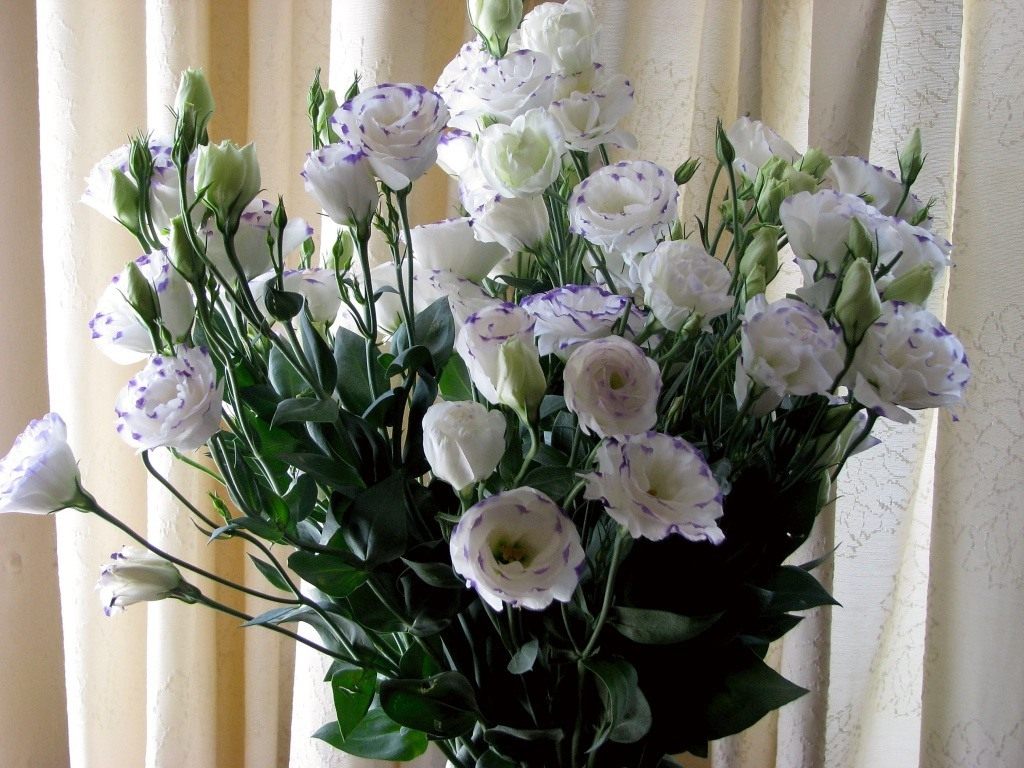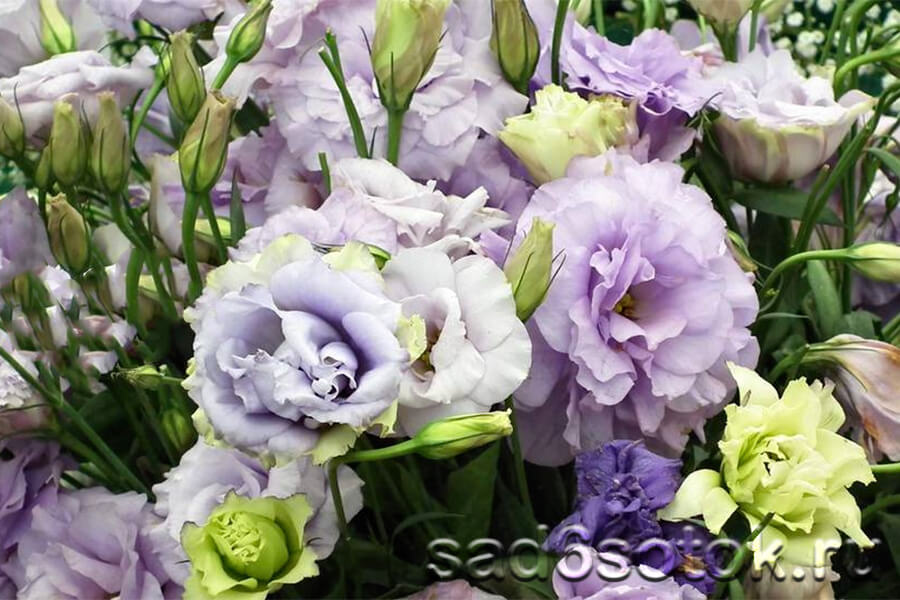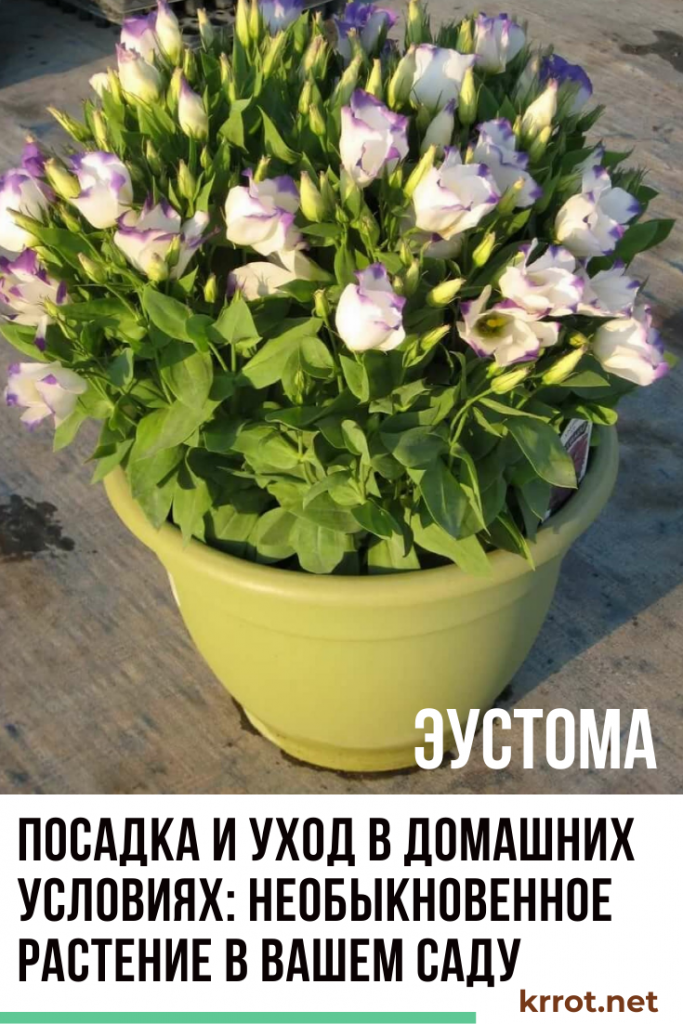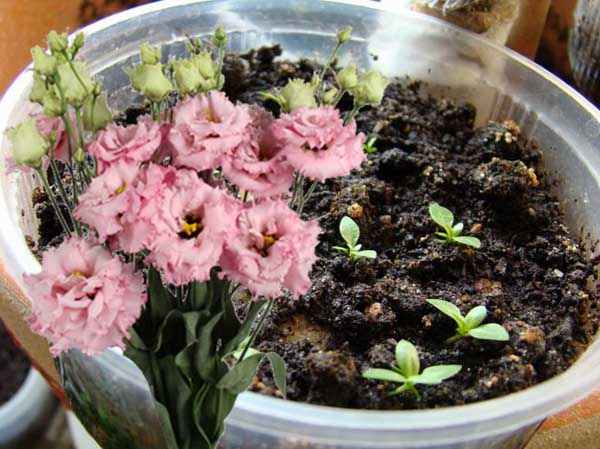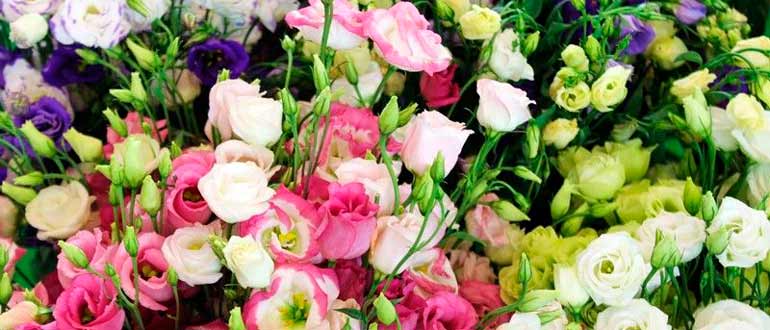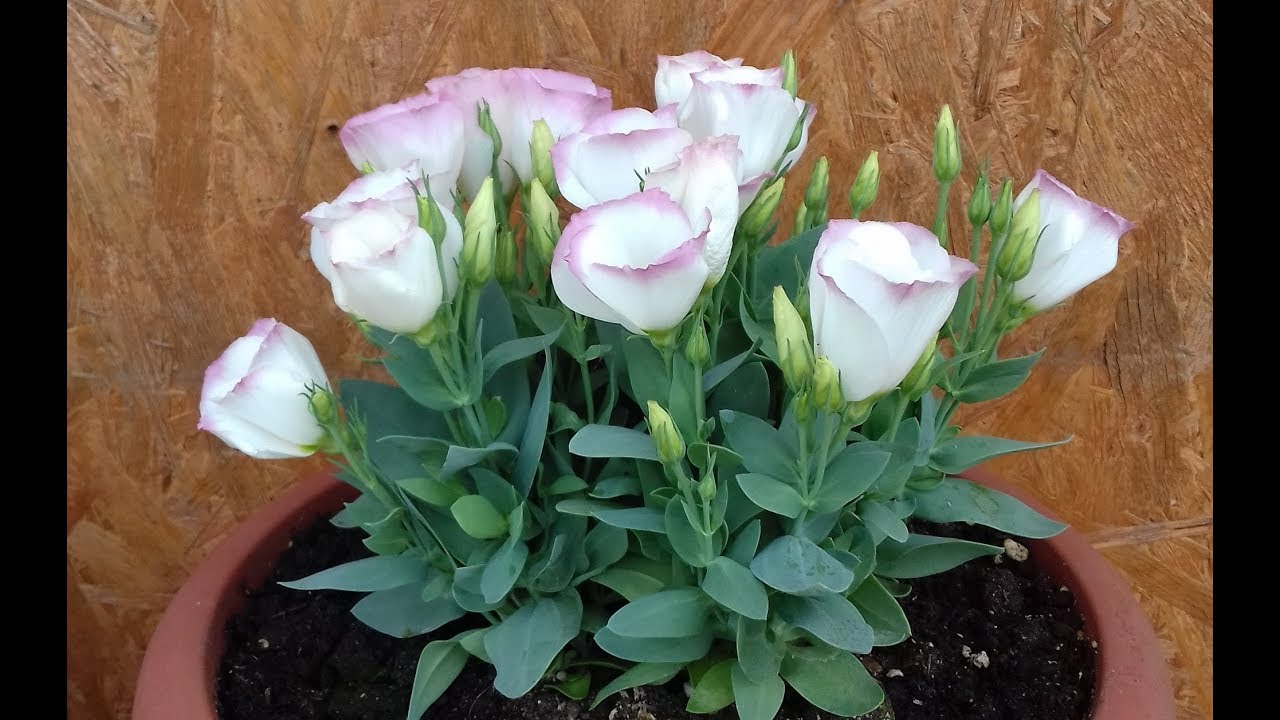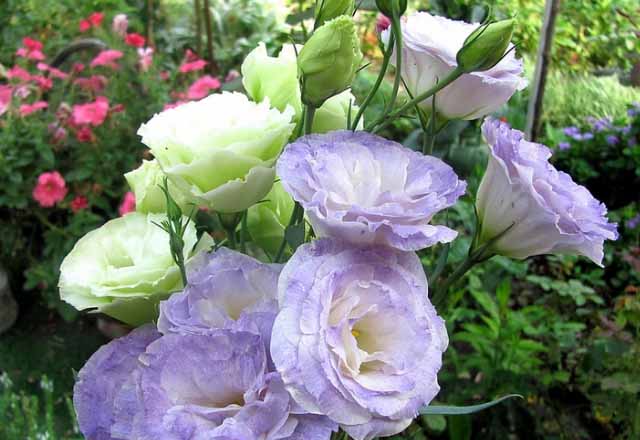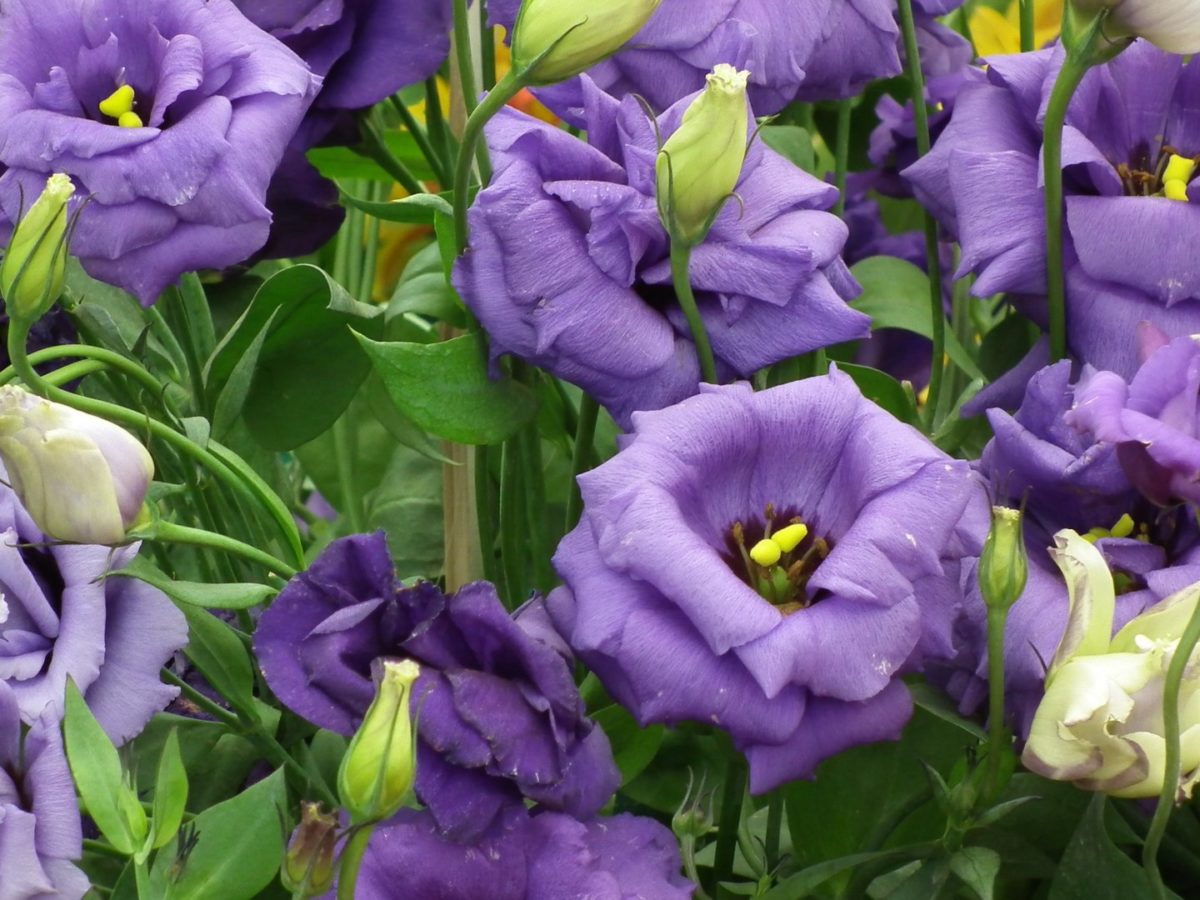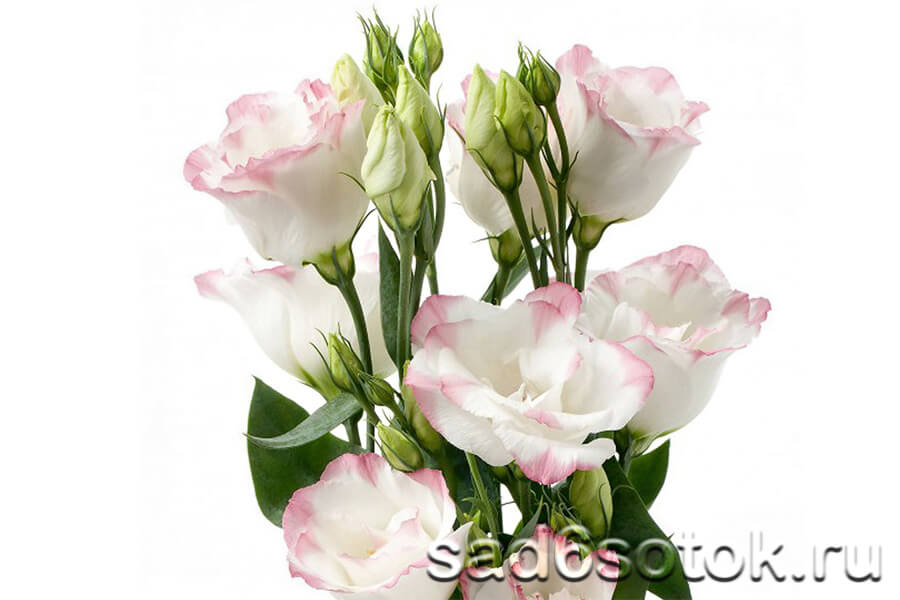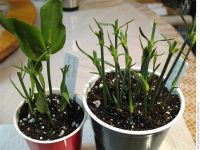Eustoma care in the garden
When planting eustoma in a garden, caring for a flower is reduced to regular watering, loosening and weeding. Also, the plant should be fed periodically.

Watering and loosening
Eustoma should be watered regularly. Drying out of the soil negatively affects the decorative properties of the plant. The buds will crumble, and new ones will stop forming. It is not worth the flower and pour. The measure is good here. The culture is watered as the earthen coma dries out
Watering should be done carefully so that water does not get on the leaves of the plant.
If, after watering, a hard crust forms on the ground, then the ground should be loosened or mulched. For mulching, bark, straw, dry hay, etc. are suitable.
Top dressing
The eustoma should be fed every two weeks. The flower especially needs feeding during the flowering period. The fertilizer should contain a high percentage of potassium and phosphorus. Moreover, the potassium content should prevail. Top dressing with such fertilizer will create conditions for a long and abundant flowering of the plant.
Potash fertilizers are divided into:
- mineral (potassium sulfate, potassium magnesium, potassium monophosphate);
- organic (wood ash).
Other activities
If the eustoma bush has grown large enough, then the plant should be tied up. The support should match the height of the flower. If the flower is not tied up in time, then it can fall under the weight of its buds.
In order for the eustoma to bloom for a long time, it should not only be fed, but also wilted flowers should be removed in time. So the plant will not spend extra energy on ripening the seeds.
Sowing eustoma seeds for seedlings
Rinse the seed pot in a pink potassium permanganate solution and fill it with the prepared potting mix. The soil should be slightly damp. Smooth the surface and compact slightly. Eustoma seeds are very small, therefore, as a rule, they are sold in a coated form. Spread them over the surface of the soil.

It is very convenient to do this with a moistened wooden toothpick or wooden oven skewer. Moisten the eustoma seeds with a fine spray bottle.
In order for the eustoma to sprout faster, gently crush the wet seed coat with a toothpick. Place the bowl in a clean plastic bag or cover with glass and place under a fluorescent lamp
Until about mid-March, eustoma seedlings should be grown under a lamp, supplemented so that the daylight hours for plants are 12 hours. The temperature of the content of eustoma seedlings at this time should not exceed + 20 ... + 25 ° С. Eustoma shoots appear 10-12 days after sowing the seeds

Place the bowl in a clean plastic bag or cover with glass and place under a fluorescent lamp. Until about mid-March, eustoma seedlings should be grown under a lamp, supplemented so that the daylight hours for plants are 12 hours. The temperature of the content of eustoma seedlings at this time should not exceed + 20 ... + 25 ° С. Eustoma shoots appear 10-12 days after sowing the seeds.
At first, seedlings grow very slowly, because they build up the root system. At this time, gradually accustom the seedlings to the air, increasing the airing time. Small shoots of eustoma do not tolerate overdrying very well and may die, so monitor the soil moisture very carefully. After 6-8 weeks, when 2-3 pairs of true leaves appear in seedlings, the eustoma is ready for picking. Despite the small size of the seedlings, it is not worth tightening with a dive, because overgrown seedlings can easily damage overgrown roots.

The soil mixture for picking eustoma is used the same as for sowing, but it does not need to be sieved and steamed. To prevent eustoma seedlings from turning black, it is enough to use a fungicide solution during the first watering after picking. When picking eustoma seedlings, it is better to use pots 6 cm wide. Fill the pots with potting soil, compact slightly so that the soil does not settle too much when watering.When planting, the holes must be such that the root system is freely located in them. Make sure that the root collar is at ground level when backfilling, and not buried in the ground.

Pour gently starting from the edge of the pot.

You can add foundationol (1 g per 1 liter of water) or another fungicide ("Vitaros", "Maxim") to the water for irrigating eustoma according to the instructions. If, during watering, the root collar of the seedling is bare, then sprinkle it with soil mixture. After picking, it is advisable to cover the seedlings with plastic wrap for the first time. For better rooting, eustoma seedlings can be sprayed with Epin solution (3-4 drops per 100 ml of water). With an increase in daylight hours, transfer the seedlings to natural light. After the pick, the seedlings grow much faster.
Features of growing eustoma as a perennial crop

Eustoma looks great both in a bouquet with other flowers, and by itself
Despite the fact that eustoma is called a perennial crop, gardeners of central Russia usually grow it as an annual. The problem is that the plant is very difficult to preserve in the autumn-winter period - in its homeland (and this is the south of North America), eustoma is accustomed to a mild climate, thanks to which it grows and blooms in the wild all year round, multiplies by self-sowing.
In Russia, on packages with eustoma seeds, as a rule, there is an indication: a one-year or two-year type of plant can be obtained from them. Biennials (and in fact perennials) acquire florists who have reliable greenhouses in which the plant will be able to survive our harsh winters. In addition, two-year-old eustoma is used as a houseplant, while in a flower pot on the windowsill it can feel great not for 2 years, but for 4–5 years. If the gardener plans to place flowers outdoors, he chooses the one-year option.
Differences from the one-year-old relative

There are a lot of varieties of eustoma for home cultivation - for every taste!
Annuals are most often tall varieties, the length of their stems is close to a meter. Perennials designed for indoor cultivation are undersized, 15–20 cm high. However, this division is very arbitrary: depending on the plans of the grower and for growing as annuals, dwarf flowers may be required.
Another significant difference between the two types of plants is that even a novice florist can easily cope with annuals. But to grow a two-year (perennial) specimen in the garden is within the power of a person with extensive experience. The flower requires special care during the growing season and competent preparation for wintering and its implementation - even minor miscalculations can lead to the death of a delicate plant.
How best to grow: outdoors or in pots

In landscape design, planting is used both in open ground and in pots.
For a long time, Russian flower growers knew eustoma exclusively as a houseplant. Today it is grown in greenhouses, winter gardens, flower beds. On alpine slides, in mixborders, eustoma fits perfectly into the overall picture due to its long flowering: starting in mid-July, it continues in September. And if the weather permits, then during the first decade of October. A single plant can bloom for 4 months, gradually opening bud by bud. If the flower is cut off, it will begin to grow from the root and in the southern regions will even have time to bloom again, which, unfortunately, does not happen in the middle lane.
When and for how long it blooms

A flower bed with eustoma is prepared taking into account the flowering time of certain varieties
The flowering time can be adjusted:
- sow the seeds in November or early December - the eustoma will bloom in June (early or mid-month);
- sow before the New Year - it will bloom in July;
- sowing in mid-January will ensure flowering in August;
- sow at the end of January or the beginning of the last month of winter - wait for flowering in September.
Eustoma tolerates light autumn frosts well. However, novice growers often make the mistake of starting to take care of eustoma seedlings in the spring. In this case, the plant simply does not have time to bloom - if the buds are formed, they go under the snow.
Container planting helps to extend the life of the plant and its flowering, for which various containers are used - pots, tubs. While it is warm, they are kept in the open air, with the onset of cold weather, they are brought into the room. Flowering continues, although it becomes more modest.
The container technology helps to preserve the rhizome of the plant during the winter in order to plant it later, already with new shoots, on a flower bed. The disadvantage of this method is that the flowering will not be as rich as usual.
What climate is this plant suitable for, on what soil it grows better

Of course, black soil is a fertile soil for most plants, but not everyone will be able to provide such conditions.
The soil for eustoma should be:
- well (without large lumps) dug up;
- drained, which means it is breathable;
- fertile (mineral fertilizers and compost are introduced into the soil);
- moderately moist, since waterlogging can cause root rot;
As for the composition, the most suitable options are black soil or a mixture of peat and humus in a 1: 1 ratio.
Since the eustoma is a thermophilic plant, it feels more comfortable in the southern regions. In central Russia, for its full growth and flowering, temperatures are needed: 20-25 ° С during the daytime and 15 ° С at night. In winter, it is advisable to keep the container with eustoma in a room where the temperature does not drop below + 10–12 ° С.
How to grow eustoma at home
Eustoma is a flora with amazingly beautiful flowers of delicate shades. They are often added to bouquets - they stand for a long time, do not fade. This plant also has a minus - it is rather capricious, requires a lot of attention to itself. The color of this flora is very similar to pink, which is why it is sometimes called that - Irish or Japanese rose.

Indoor eustoma
Important! Some people wonder if eustoma can be grown as a houseplant. The answer to it is positive: it is grown both in the garden and at home.
What is remarkable is that the same species is used everywhere - the large-flowered eustoma, or eustoma grandiflorum. She is now called Lisianthus Russell.
In height, an adult lisianthus bush is from 15 to 90 centimeters, during the flowering period it releases about twenty flowers. They do not dissolve at the same time, but one after the other. Because of this, the beauty of the blooming flora is preserved for a rather long period.
Until recently, this culture was considered a garden or greenhouse. Today, eustoma can often be found in the home. When preparing to acquire such a flower, you need to consider the following:
- In nature, lisianthus is a perennial plant. In the house he is often kept only during the flowering season. For the winter, he needs conditions, which are quite difficult to recreate in an apartment. Even if it succeeds, you cannot make a full-fledged perennial at home from it.
- Be sure to clarify what kind of flowers it is. A home needs crops that can survive in pots. They shouldn't grow taller than 30 centimeters.
- Most likely, after the purchase, a bush, even a dwarf one, will begin to grow in breadth and upward. This is because in order to speed up and reduce the cost of the growing process, plants are fertilized with growth inhibitors.

Sale of eustoma seedlings
To avoid the latter, you can grow this flora at home on your own. It is best to start from scratch, that is, germinate the seed.
Planting eustoma seeds
If you start dividing a flower, none of the seedlings will take root, since their root system is very sensitive to any mechanical stress. Eustoma cuttings also do not take root - when they are detached from the main stem, they die completely after some time.
The only possible reproduction option for a plant is planting with seeds.Have you already bought your favorite flower variety and prepared a place for it? Then start preparing seedlings. To see flowering by mid-summer, work in February-March using special peat tablets (found in any gardening store). They are inexpensive and easy to use.
Peat tablets
The technology is as follows:
• Place the peat tablet in a small container (you can use a plastic cup), spray it to swell the substrate a little.
• Place 2-3 eustoma seeds on the nutrient medium, lightly pressing them with a toothpick. Do not bury the seeds, because they need light for germination - they will not see it in the depths of the tablet.
• Spray the peat tablet again with water or potassium permanganate solution from a spray bottle.
• Cover the top of the container with cling film or a bag to create a mini greenhouse.
The rules for planting eustoma in seedling boxes with soil are exactly the same.
For eustoma seeds to germinate, they need a temperature of + 20 ... + 22 ° С. The first shoots may appear above the ground in 1-2 weeks, and leaves on the stems will appear after a month. Look in stores - varieties of eustoma have already been bred that can germinate much faster and at lower temperatures. Let's designate the main features of caring for flower seedlings:
• Occasionally remove accumulated condensation from the film covering the container with seeds.
• Spray the plant occasionally with phytosporin solution to prevent blackleg formation.
• Water seedlings only when the substrate dries up - along the edge of the container.
• Seedlings will gain strength faster if they are regularly sprayed with special mineral preparations that stimulate growth.
• After planting the seeds in the seedling box, in the phase of 2-3 full-fledged leaves, dive the eustoma into separate containers. This is a rather laborious matter, since the root system of the plant can be damaged. Therefore, it is recommended to use peat tablets.
Eustoma seedlings ready for planting
Do not rush to transfer the flower to a permanent place - young seedlings should get stronger. Planning to move your plant to an open area? Then do not forget about its preliminary hardening. The landing is made when the threat of late spring frosts has passed. Pour the previously dug holes with water, transfer the seedlings into them with a lump of "native" earth. At the same time, the distance between the flowers is 15-30 cm. Be sure to cover the new inhabitant of the garden with a plastic bottle with a cut off neck - this way you will save the plant from the cold at night, creating a greenhouse environment. The shelter can be removed after 2-3 weeks.
At home, everything is much simpler - plant in pots or pots when 5-7 leaves appear on the plant. If you used peat tablets to prepare the seedlings, transplant the eustoma right with them. Place the container in a lighted place - the eustoma now needs abundant light.
How to care for eustoma?
Caring for eustoma is often difficult for beginners. The flower is not too whimsical, but it requires maintaining a certain level of temperature and lighting. The basic rules are as follows:
• Watering. Be sure to moisten the soil on top and along the edge of the pot. For this, use settled water at room temperature - the delicate flower will not tolerate cold liquid. Do not "flood" the eustoma, but make sure that the soil is always slightly damp - water it as soon as the top layer of the earth begins to dry out. When a plant is actively blooming, it will be necessary to moisten the soil much more often - it now needs more nutrients for growth and development.
• Temperature. The optimum temperature range for eustoma during the period of active growth and flowering is +23 ° C ... + 25 ° C. In the summer, this is easily achievable both in the garden and at home, if the place for growing the heat-loving beauty was initially chosen correctly.When the eustoma fades and begins to prepare for wintering, it no longer needs a warm microclimate - 15 ˚C will be enough.
• Lighting. Eustoma requires an abundance of light when caring for it. And it would be good if he fell on the plant from the south, east or west side. If there is still no light place for the flower, during the period of growth and flowering, supplement it with special lamps, otherwise you will not see beautiful and large buds. But during the dormant period, the plant lives well even with a lack of light.
• Air humidity. Eustoma loves humid air. At home (especially in dry summers) it can be difficult to achieve this. If possible, install a humidifier in the room where the flower grows.
• Top dressing. Eustoma needs regular fertilization. Start feeding one month after planting the seedlings in their permanent place (around May-June) using any water-soluble fertilizer for flowering plants. Feed the eustoma once a week throughout the flowering period. When the buds have faded, you can reduce fertilizers to once every 2-3 weeks, and in late autumn - stop using them altogether.
• Cropping. To stimulate the development of new shoots, pluck those buds that have already bloomed and dried leaves. Avoid the strong foliage of the ornamental bush - this can lead to the formation of fungal diseases - from time to time, carry out formative pruning.
• Preparing for winter. When growing eustoma at home, it does not need special preparation for a state of dormancy. But she will not tolerate cold weather in an open area. There are 2 options - either completely dig up the flower, and plant new seeds for the next season, or transfer it to the house
In the latter case, you will need to choose a pot that is suitable in size and carefully transplant the plant and place the container in a bright, cool room. In the spring, when the ground warms up enough, you can again transplant the eustoma into the open ground.
Move the plant into larger pots as it grows.
Transplant with caution, as even an adult plant can react poorly to damage to the root system. Fill a new container with soil of the same composition.
Description of culture
Eustoma is an extraordinary flower. Its strong stems are similar in structure to carnation ones and, along with them, can grow up to 1 m in height. One branch of eustoma looks like a ready-made bouquet, and all thanks to the increased branching of the stem. The number of neat buds on one branch reaches 35 pieces. They dissolve in turn, as if replacing each other. Eustoma leaves can be gray or bluish in color with a matte surface. In shape, the leaf plates resemble an elongated oval.
Ripe flowers are funnel-shaped. Their calyx ranges from 5–8 cm in diameter. Eustomas with pink and purple flowers are much more common, although there are white and purple buds.

Eustoma is not the only name for this majestic flower. The most common names used in garden conversations are lisianthus, Irish rose, or blue bell.
In the wild, eustoma lives for only 2 years, but mother nature awarded the plant with such a lifetime. The growing process is 1 season. Growing in a flowerpot, eustoma will be able to delight the eyes of its owners for 4 or even 5 years. The lifespan of an eustoma growing in open garden ground is 2-3 years.
The process of growing eustoma cannot be called simple. First, it takes quite a long time. Secondly, it requires the most accurate execution of each step. Of course, eustoma is a capricious plant, but if everything is done correctly, the result will delight the owner of the garden.


Types of Eustoma and popular varieties

As you know, Eustoma is very diverse. It can be terry and non-terry.Until the flower has blossomed, it is very difficult to distinguish it from rosebuds, and the blossoming Eustoma looks like poppy flowers.
Consider some cut varieties of this plant:
-
Eustoma Echo Pink Pikoti F1 is a plant, about 70 cm high. Double flowers, early flowering. The colors can be either one-color or two-color. In the cut form, it remains for a long time.
Eustoma Echo Pink Pikoti F1
- Aurora. This species is famous for its variety of colors. It can be white, light blue, blue or pink. Coloring the petals. The plant is more than 130 cm tall. It begins to bloom quite early.
-
Mermaid (Mermaid). The species is low-growing, no more than 20 cm high. The bush is very spreading. It blooms in white, blue, pink and purple flowers.
Eustoma the Little Mermaid blue F1
- Flamenco. Tall, reaching 120 cm in height, eustoma, large-flowered, buds grow up to 8 cm. Eustoma has won the hearts of many gardeners. Moreover, this variety is not very whimsical.
- Heidi. This profusely flowering Eustoma of medium height has a stem, flowers of predominantly simple type, the color is very diverse, up to 15 different options.
- Little Bell. This is a variety of low-growing Eustoma. The size of the bush is not more than 15 cm. The flowers are mostly simple, medium-sized with a rich range of shades.
Of course, these are far from all varieties of this plant. In fact, there are a lot of them.
Step-by-step planting technique
Algorithm of actions for sowing:
- Fill container or personal containers with light soil, level and tamp a little.
- Spread the seeds over the surface of the soil or in shallow grooves at a distance of 1-1.5 centimeters. Sprinkle with a layer of sand to avoid the development of the black leg. In this case, the crops should be slightly visible.
- Moisten crops with a spray bottle.
- Create greenhouse conditions using glass containers, polyethylene.
Upon completion, place the container or flowerpot in a warm place for germination, where the air temperature is within 21-24 degrees.
Growing seedlings
In principle, it is not difficult to grow eustoma seedlings.
However, it is very important to comply with the conditions that allow you to grow quality sprouts. If you follow all the instructions, on the 10-12th day you will be able to see how the first shoot sprouts
It is at this moment that the gardener will feel pride in himself and his capabilities. Only in this euphoria, in no case should you forget to keep an eye on your flourishing "children".
Picking
With the onset of 2 months of age, eustoma must be subjected to a diving procedure. This will require preparing containers such as small pots or paper cups. The dishes must be treated with a weak solution of potassium permanganate. After that, drainage is laid out at the very bottom of the pots. It can be pebbles, expanded clay or pieces of broken brick. Soil is poured on top of the drainage layer. Its composition should be the same as that used when planting the seeds. Use a toothpick, match or pencil to make small indentations.
A container with grown seedlings is watered with settled water. Then, using a spatula, the strongest shoots should be removed from the total mass and carefully rearranged into prepared containers for diving.


Top dressing
During the first two months of its life, eustoma develops extremely slowly. The first leaves of seedlings appear 6 weeks after germination. But this does not mean that seedlings need feeding. The given dates correspond to the normal development of Lisianthus. And the soil used for planting contains all the necessary minerals and nutrients, which are quite enough for the plant.
Transshipment
As soon as the first 6–8 leaves of young seedlings have blossomed, they should be transplanted into larger containers, for example, 0.5 liter pots or cups. The transplanting process is similar to the picking procedure.The main thing is to carefully remove the sprouts so as not to damage the young root system.
Follow-up care of transplanted plants is easy
It is important to monitor the moisture content of the soil composition, watering as needed. The same goes for feeding

Eustoma in greenhouse conditions: recommendations for growing
Table of the influence of auxins on the process of eustoma rhizogenesis.
Eustoma grows well in the greenhouse. In the daytime for this plant, it is recommended to maintain a temperature level of 21-22 degrees, and at night - at a level of 15 degrees. In addition, growing flowers requires a heating system, especially during periods of sun exposure. Some experts recommend simply covering the glass with chalk. This simple method makes it possible to increase the growing temperature in winter, saving energy for heating.
Among the features of growing flowers in a greenhouse, it should be noted the need to apply organic fertilizers to the soil every day. For this, a small number of them, about one centimeter, is enough. If this is not ensured, then the structure, the quality of the eustoma can greatly deteriorate.
The second period of growing flowers in a greenhouse involves spraying moisture from below and from above. In the first half of the entire period, water is sprayed only from above, drip irrigation can be used, in the second period, spraying from below is added. In winter, such measures can only be taken when the temperature in the greenhouse is at least 15 degrees Celsius.
Growing eustoma in a greenhouse requires regular feeding. To choose the right fertilizer, it is necessary to first analyze the soil, the nutritional value of which can be adjusted using basic fertilizers.
Much attention is paid to top dressing in the second period of flower cultivation, since it is at this time that the number of watering is reduced. Pay attention to the soil, which must be plowed, so that moisture is evenly distributed inside
This is very important as the root system takes root quite deeply. Greenhouse scheme for flowers
Greenhouse scheme for flowers.
For support in the greenhouse, a special mesh must be used. They must be placed in increments of 4 meters, the mesh itself, which is stretched between the supports, should be treated with a disinfectant solution. Eustoma in the greenhouse can be grown all year round, but different varieties are used for each period. In autumn and winter, artificial lighting is applicable.
Planting eustoma flowers is carried out as follows: only one plant is placed in one cell, while the density should be from 60 plants to 90 per square m. The soil for planting must be preheated, its temperature should not be less than 15 degrees. Eustoma is grown in several stages:
- an initial stage lasting one (plus two) weeks;
- stage for vegetative growth lasting 3-8 weeks;
- seedling stage, taking 9-18 weeks;
- flowering stage, lasting from 19 to twentieth weeks.
The eustoma is activated in the morning, so it is necessary to raise the temperature to 30 degrees, turn on higher revolutions for ventilation, but the vents must be closed. The moisture supply should be uniform, the most optimal is bottom or drip irrigation. When the first buds open, only the lower one is watered. The level of lighting for growing flowers also requires attention. Eustoma likes high light intensity, but shading is required between May 15 and July 15.



